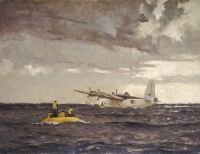








Dazzle camouflage, also called as dazzle painting, was a family of ship camouflage used extensively in World War I and to a lesser extent in World War II and afterwards. Credited to artist Norman Wilkinson, though with a prior claim by the zoologist John Graham Kerr, it consisted of complex patterns of geometric shapes in contrasting colours, interrupting and intersecting each other.
Unlike some other forms of camouflage, dazzle works not by offering concealment but by making it difficult to estimate a target's range, speed and heading. Norman Wilkinson explained in 1919 that dazzle was intended more to mislead the enemy as to the correct position to take up than actually to miss his shot when firing.
Dazzle was adopted by the British Admiralty and the U.S. Navy with little evaluation. Each ship's dazzle pattern was unique to avoid making classes of ships instantly recognisable to the enemy. The result was that a profusion of dazzle schemes were tried, and the evidence for their success was at best mixed. So many factors were involved that it was impossible to determine which were important, and whether any of the colour schemes were effective.
Dazzle attracted the notice of artists such as Picasso, who claimed that cubists had invented it. The vorticist artist Edward Wadsworth, who supervised the camouflaging of over 2,000 ships during the First World War, painted a series of canvases of dazzle ships after the war, based on his wartime work.
Art History
The abstract patterns in dazzle camouflage inspired artists including Picasso. He claimed credit for camouflage experiments which seemed to him a quintessentially Cubist technique.In a conversation with Gertrude Stein shortly after he first saw a painted cannon trundling through the streets of Paris.Edward Wadsworth, who supervised dazzle camouflage painting in the war, created a series of canvases after the war based on his dazzle work on ships. In Canada, artists from the Group of Seven, notably Arthur Lismer, used dazzle ships in many wartime compositions.
In 2007, the art of concealment, including the evolution of dazzle, was featured as the theme for a show at the Imperial War Museum.In 2009, the Fleet Library at the Rhode Island School of Design exhibited its rediscovered collection of lithographic printed plans for the camouflage of World War I US merchant ships, in an exhibition titled "Bedazzled."In 2014, the Centenary Art Commission backed two dazzle camouflage installations in the UK.In the first, the former HMS Saxifrage, anchored since 1922 at Blackfriars Bridge in London, was painted by the German artist Tobias Rehberger in the manner of dazzle camouflage. And in the second, Venezuelan kinetic artist Carlos Cruz-Diez was commissioned to cover the Edmund Gardner pilot ship, in Liverpool's Canning Dock, with bright multi-coloured dazzle artwork, as part of the city's 2014 Liverpool Biennial art festival.Also in 2014, Rehberger painted HMS President to commemorate the use of dazzle, a century on.